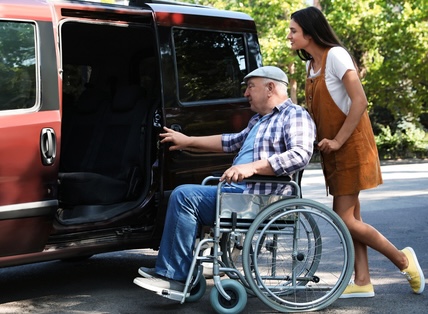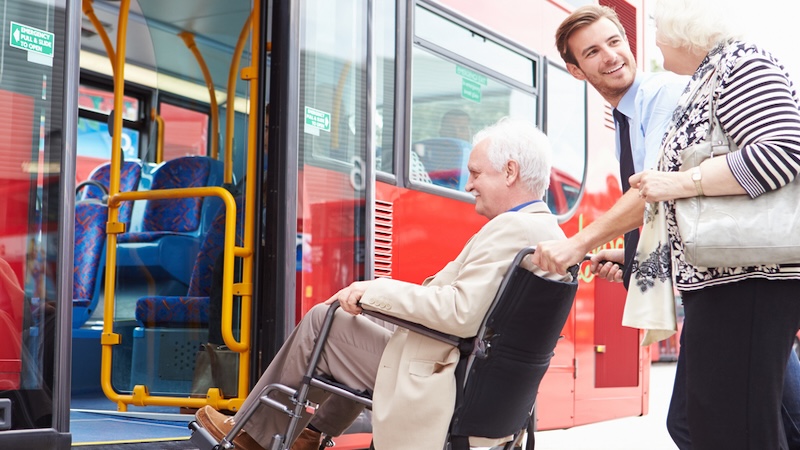Transportation is important for maintaining a fulfilling life. Seniors who no longer drive or who are considering giving up driving soon may wonder what the alternatives are for getting around. In truth, a lot depends on where you live and what transportation services for seniors are available in your community. How mobile you are – whether you are able to travel independently without assistance – is another important consideration when choosing the right services for your needs.
In cities and semi-urban areas, there are typically more public transportation options, which may be limited or nonexistent in rural communities. The good news is that ride-sharing services now exist almost everywhere in the U.S. and can help fill in the gaps where public transportation is lacking. Many communities also have volunteer programs to give rides to their senior residents.
Whether or not you are aging in place at home or have transitioned to a retirement community, you still need to have transportation to and from doctor’s appointments and other places you need to go. Fortunately, many assisted living facilities now provide transportation options such as shuttles buses with regular trips into the surrounding communities, in addition to a plethora of additional services.
Transportation is critical for seniors
Transportation is especially important for seniors who remain in their homes, so they can access medical care and other essential services. The negative consequences of not having reliable transport services for seniors can range from missed health appointments and increased emergency hospital visits to a lack of continual care and social isolation, the latter of which can impact both mental and physical health, according to the National Aging and Disability Transportation Center (NADTC).
 Another important fact is that the burden of providing transportation to seniors who no longer drive often falls on caregivers. According to the National Alliance for Caregiving and AARP, 78% of caregivers either provide or arrange rides for their loved ones, providing more than one billion rides per year.
Another important fact is that the burden of providing transportation to seniors who no longer drive often falls on caregivers. According to the National Alliance for Caregiving and AARP, 78% of caregivers either provide or arrange rides for their loved ones, providing more than one billion rides per year.
Seniors who can’t access reliable transportation from a family member, friend, caregiver, or through a service may find aging in place to be too challenging.
4 transportation services for seniors
Here’s a closer look at four transportation services that seniors and their caregivers should consider:
1. Public transportation
Seniors who live in areas where it’s available should find this to be one of the most affordable choices for getting around. In fact, many government-sponsored bus and rail services offer discounted fares to seniors. However, seniors must be mobile enough to get to pickup locations or have someone drop them off. In most cases, they must also be mobile enough to enter and exit the bus or train independently.
2. Paratransit
For seniors in areas with public transportation who need more assistance, paratransit services is often available. This is because the Americans with Disabilities Act (ADA) requires communities that provide fixed-route public transportation to offer complementary paratransit services. This applies to public transit agencies and to private entities that operate public transportation services. Paratransit services typically pick up seniors where they live and take them to their destinations and back, while also providing a personal care attendant to assist them.
3. Ride-sharing apps
Ride-on-demand services like Uber and Lyft are available now almost everywhere you go, even in rural communities. Though they aren’t the least expensive choice, they offer seniors a great deal of flexibility. Riders can get a lift when they need it 24/7 to almost anywhere they want to go within a short notice of an hour or less. Smartphone-savvy seniors can easily and quickly book rides themselves. For seniors unable or unwilling to use a smartphone app, a service called GoGoGrandparent lets you book rides through Uber and Lyft by simply calling a phone number and speaking to an operator. The service charges a small fee, but in addition to ride-sharing, it can also be used for other services such as food and grocery delivery through DoorDash or Instacart.
4. Nonprofit groups
Many nonprofit groups provide free or low-cost rides to help seniors get back and forth to medical appointments, grocery stores, and other places they need to go. In Richmond, Virginia, for instance, several services offer senior transportation, including Let’s Go Services, a nonprofit that provides donation-based transportation for seniors, veterans, and families in need; and the Shepherd’s Center of Richmond, which offers free rides to medical appointments and grocery stores for those 60 and older who can no longer drive. Both services require that trips be scheduled a couple of weeks ahead of time.
Throughout the country, Area Agencies on Aging can connect transport services for seniors with those who need them.
For more on how to get from place to place in your senior years, continue reading about transport services for seniors. Caregivers can visit our guide to senior support to learn more about general services available in your area.




